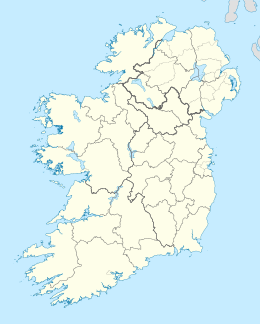Native name: Sceilg Mhichíl | |
|---|---|
 Skellig Michael | |
| Geography | |
| Location | Atlantic Ocean |
| Area | 21.9 ha (54 acres)[1] |
| Highest elevation | 218 m (715 ft)[2] |
| Administration | |
Republic of Ireland | |
| County | Kerry |
| Demographics | |
| Population | 0 |
| Official name | Sceilg Mhichíl |
| Criteria | Cultural: iii, iv |
| Reference | 757 |
| Inscription | 1996 (20th Session) |
Skellig Michael (Irish: Sceilg Mhichíl [ˌʃcɛlʲəɟ ˈvʲɪçiːlʲ]), also called Great Skellig (Irish: Sceilig Mhór [ˈʃcɛlʲəɟ woːɾˠ]), is a twin-pinnacled crag 11.6 kilometres (7.2 mi) west of the Iveragh Peninsula in County Kerry, Ireland. The island is named after the archangel Michael, with "Skellig" derived from the Irish language word sceilig, meaning a splinter of stone. Its twin island, Little Skellig (Sceilig Bheag), is smaller and inaccessible (landing is not permitted). The two islands rose c. 374–360 million years ago during a period of mountain formation, along with the MacGillycuddy's Reeks mountain range. Later, they were separated from the mainland by rising water levels.
Skellig Michael consists of approximately 22 hectares (54 acres) of rock, with its highest point, known as the Spit, 218 m (714 ft) above sea level. The island is defined by its twin peaks and intervening valley (known as Christ's Saddle), which make its landscape steep and inhospitable. It is best known for its Gaelic monastery, founded between the 6th and 8th centuries, and its variety of inhabiting species, which include gannets, puffins, a colony of razorbills and a population of approximately fifty grey seals.[3] The island is of special interest to archaeologists, as the monastic settlement is in unusually good condition. The monastery is situated at an elevation of 170 to 180 m (550 to 600 ft), Christ's Saddle at 129 m (422 ft), and the flagstaff area at 37 m (120 ft) above sea level.[4]
The monastery can be approached by narrow and steep flights of stone steps which ascend from three landing points. The hermitage on the south peak contains a dangerous approach and is largely closed to the public. Because of the often difficult crossing from the mainland and the exposed nature of the landing spots, the island is accessible only during summer months. UNESCO designated Skellig Michael a World Heritage Site in 1996.[2]
- ^ Bourke et al. 2011, p. 3.
- ^ a b UNESCO.
- ^ Lavelle 1976, pp. 31–2.
- ^ O'Shea 1981, p. 3.
